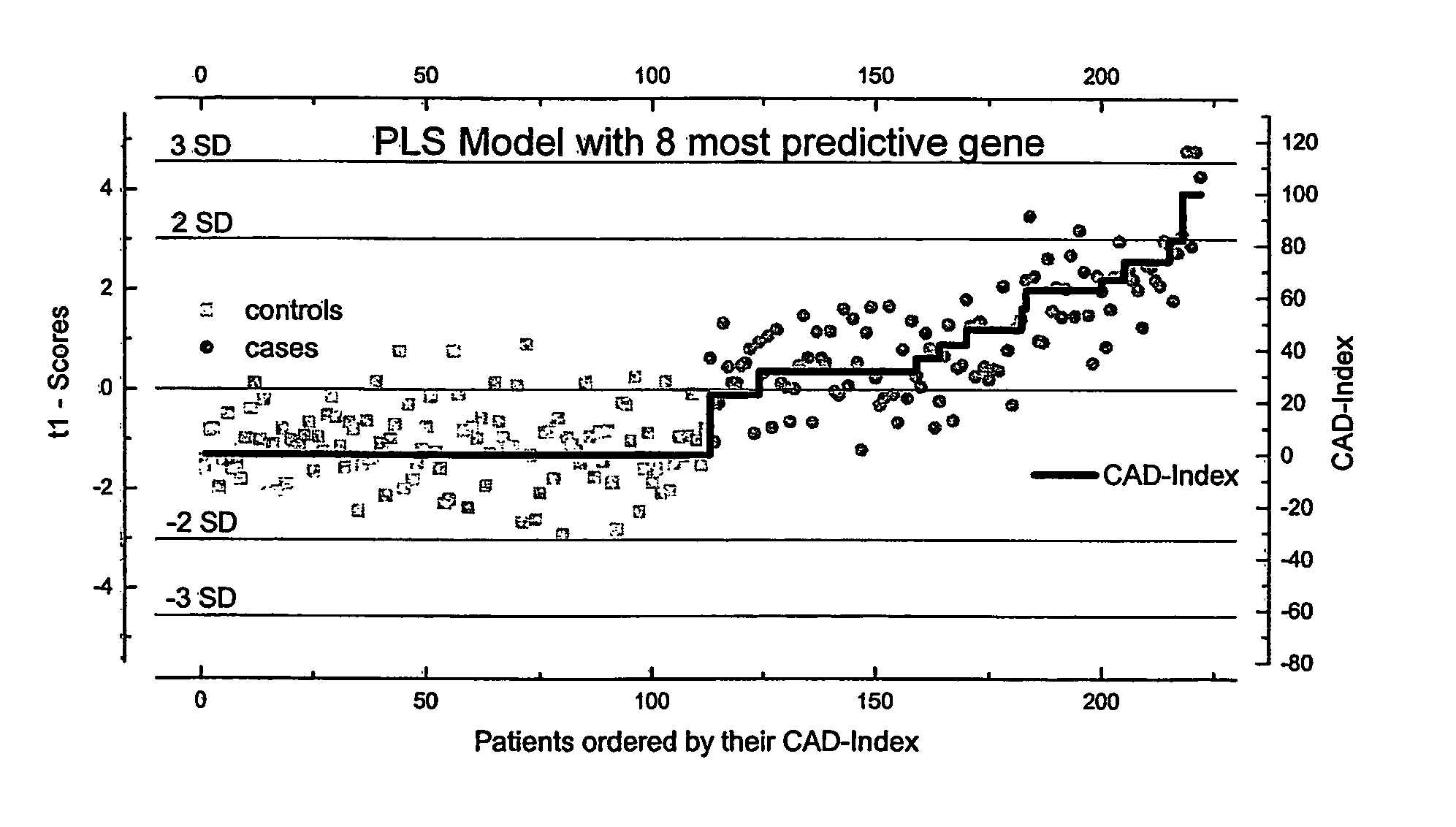Differentially Expressed Genes Related to Coronary Artery Disease
a differentially expressed gene and gene technology, applied in the field of genes, can solve the problems of insufficient definition and reproducibility of how genetic variants relate to coronary disease, and achieve the effect of improving the reproducibility of the insigh
- Summary
- Abstract
- Description
- Claims
- Application Information
AI Technical Summary
Benefits of technology
Problems solved by technology
Method used
Image
Examples
example 1
[0091] Patients and control subjects are from the “Duke Databank for Cardiovascular Disease and the Duke Cardiac Catheterization Laboratory” of the Duke Clinical Research Institute (DCRI). After the subjects provide informed consent, additional clinical data is collected to supplement the clinical database. Patients with coronary artery disease are recruited at the time of their procedure while in the cardiac catheterization laboratory and the control population are recruited both from the cardiac catheterization laboratory and retrospectively within two years of cardiac catheterization.
[0092] Populations are defined in order to minimize differences in plasma proteins unrelated to the presence or absence of coronary artery disease. Three different cohorts of subjects and controls are enrolled:
[0093] (i) “pooled males” are matched for age and ethnic group. Major diseases known to be associated With differences in proteins such as diabetes mellitus and inflammatory conditions such a...
example 2
Extension of the Modeling (Model 2)
[0131] The modelling procedure is repeated with 152 candidate genes, i.e. the 160 candidate genes of Table 6 minus the eight predictive genes of Table 7 of Example 1 by using exactly the PLS methods as for model 1 (Example 1). The CAD-index as predicted by gene expression pattern of 19 genes (Table 9) versus the actual CAD-index as assessed by the clinicians are displayed in FIG. 4. r2 of model 2 is only marginally less than that of model 1 (Example 1) (0.75 versus 0.72) and the 95% prediction confidence bands are comparable.
TABLE 9The 19 best predictor genes of model 2.SymbolAccession #Gene NameMedian*rhoSEQ ID NOPMS2L5NM_174930.2postmeiotic4960.24SEQ ID NO. 9segregation increased2-like 5RXRANM_002957retinoid X receptor,4660.24SEQ ID NO. 10alphaGCN5L1NM_001487GCN5 general control5400.23SEQ ID NO. 11of amino-acidsynthesis 5-like 1(yeast)CABIN1NM_012295calcineurin binding4820.21SEQ ID NO. 12protein 1LGALS9NM_002308.2,lectin, galactoside-3910.25S...
example 3
Extension of the Modeling (Model 3)
[0132] In a third modelling approach the remaining 133 genes, i.e. the 160 candidate genes (Table 6) minus the eight predictive genes (Table 7; Example 1) of model 1, minus the nineteen predictor genes (Table 9; Example 2) of model 2 are subjected to partial least square regression as described in Example 1. The result is depicted in FIG. 4 and the corresponding 15 best predictor genes are compiled in Table 10.
TABLE 10The 15 best predictor genes of model 3.SymbolAccession #Gene NameMedian*rhoSEQ ID NOPTP4A1NM_003463.2protein tyrosine620.27SEQ ID NO. 28phosphatase typeIVA, member 1PAFAH1B1NM_000430.2platelet-activating2040.27SEQ ID NO. 29factoracetylhydrolase,isoform lb, alphasubunitSOX4NM_003107.2SRY (sex determining540.20SEQ ID NO. 30region Y)-box 4ASNA1NM_004317.1arsA arsenite3600.21SEQ ID NO. 31transporter, ATP-binding, homolog 1(bacterial)MAN2A2NM_006122.1,mannosidase, alpha,3580.28SEQ ID NO. 32NM_006122.1class 2A, member 2NFYCNM_014223.2nu...
PUM
| Property | Measurement | Unit |
|---|---|---|
| diastolic blood pressure | aaaaa | aaaaa |
| temperature | aaaaa | aaaaa |
| temperature | aaaaa | aaaaa |
Abstract
Description
Claims
Application Information
 Login to view more
Login to view more - R&D Engineer
- R&D Manager
- IP Professional
- Industry Leading Data Capabilities
- Powerful AI technology
- Patent DNA Extraction
Browse by: Latest US Patents, China's latest patents, Technical Efficacy Thesaurus, Application Domain, Technology Topic.
© 2024 PatSnap. All rights reserved.Legal|Privacy policy|Modern Slavery Act Transparency Statement|Sitemap



